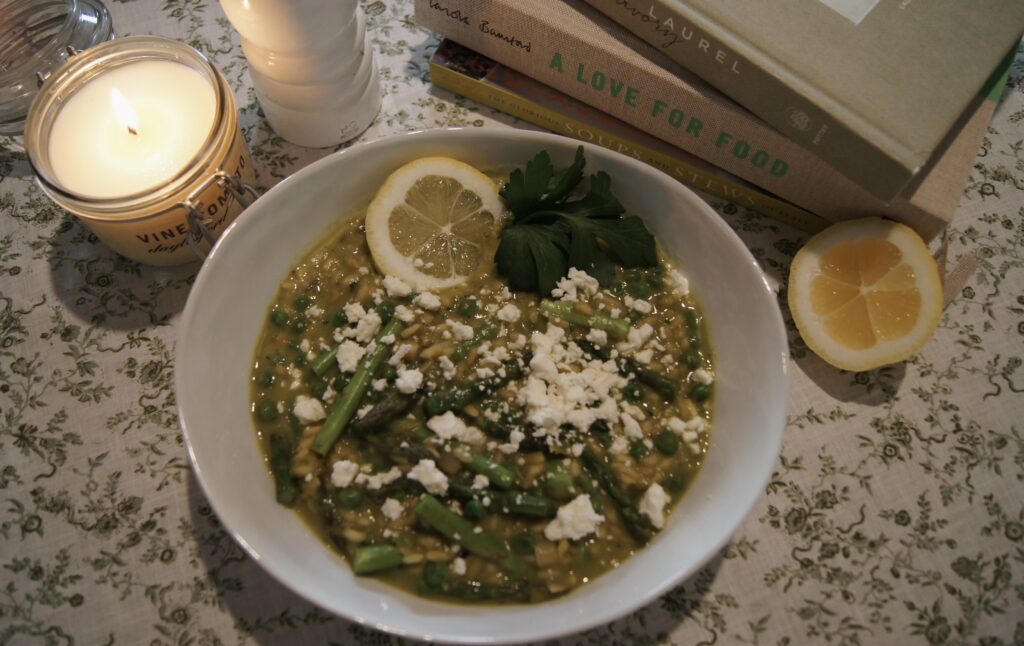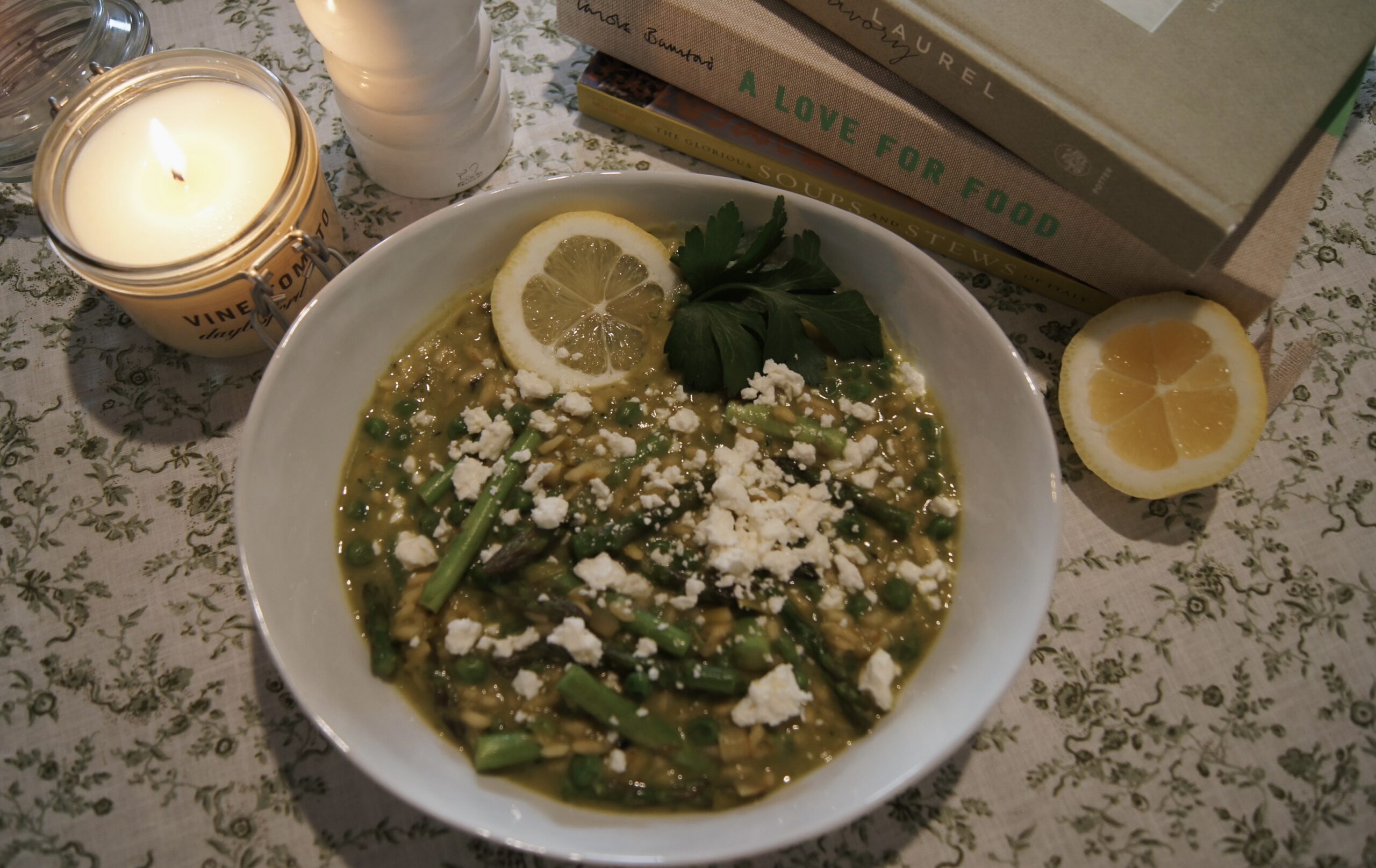As the days get longer and warmer weather is upon us, I find myself leaning into lighter dishes that still offer the comfort we crave in early spring. This spring vegetable risotto is a favorite in our kitchen—creamy, vibrant, and full of nourishing ingredients that celebrate the season.
Made with tender asparagus, sweet peas, fresh lemon, and high-quality olive oil, this healthy risotto recipe is a refreshing take on a traditionally rich dish. It’s gluten-free, naturally vegetarian (unless you top it with your favorite protein), and easy enough for a weeknight dinner.

Why We Love This Spring Vegetable Risotto Recipe
After more than a decade of gluten-free living, risotto has become my go-to alternative to pasta. Arborio rice has the same satisfying creaminess you’d expect from a comforting bowl of noodles, with the added benefit of being naturally gluten-free and rich in magnesium and essential minerals.
This lemon risotto recipe is light and fresh, thanks to the addition of spring vegetables. The blanched asparagus brings a gorgeous green hue to the dish, while peas add fiber, antioxidants, and a surprising boost of plant-based protein.
Ingredients That Shine
Each ingredient in this seasonal vegetable risotto is chosen with purpose. A few favorites include:
- Arborio rice – Naturally gluten-free and rich in texture
- Extra Virgin Olive oil – A lighter, heart-healthy alternative to butter used in most traditional risottos
- Asparagus – Packed with fiber, folate, and vibrant spring color
- Peas – Plant-based protein and natural sweetness
- Fresh lemon – Adds brightness and acidity to balance the creaminess
How to Make Spring Vegetable Risotto (Step-by-Step)
Making risotto at home doesn’t have to be intimidating. In fact, it’s one of the most meditative dishes I cook—it’s slow, intentional, and rewards you with a perfectly creamy texture.
1. Sauté aromatics – Start by gently cooking shallots or onions in olive oil.
2. Toast the rice – Stir in arborio rice and toast until the edges turn translucent.
3. Deglaze with wine or vinegar – A splash of white wine or white wine vinegar adds depth.
4. Add broth slowly, in batches – Warm vegetable broth works best. Stir frequently.
5. Stir in spring vegetables – Add blanched asparagus and fresh peas near the end.
6. Finish with lemon and herbs – Add lemon zest, a squeeze of juice, and fresh parsley.
Optional Protein Pairing: Risotto with Salmon
While this spring risotto with asparagus and peas is lovely on its own, we often top it with wild-caught sockeye salmon for a complete and nourishing meal. The richness of the fish pairs beautifully with the lemony, herbed risotto base.
A tip from the Elmsgrove Lane kitchen: Pan-sear the salmon with a little olive oil, lemon zest, and dill for a perfectly crisp finish.
How to Serve It
This gluten-free risotto is incredibly versatile. Serve it as:
- A lighter take on a traditional, well-loved main course
- A side dish for spring gatherings and Easter brunch
- A base for grilled chicken, shrimp, or salmon
- A vegetarian meal topped with microgreens or soft herbs
Final Thoughts
This spring vegetable risotto is one of those recipes that feels like a little celebration of the season. It’s creamy, bright, and endlessly comforting—exactly what I want from a spring evening at home. Whether you’re hosting a dinner party or simply nourishing your family midweek, I hope this recipe finds a happy place at your table.
PrintSpring Vegetable Risotto with Asparagus, Peas & Lemon
Made with high-quality olive oil and lots of fibrous green veggies, this risotto healthier take on rich risottos that can often be found in restaurants.
Ingredients
- 1 large bunch asparagus
- 1 1/2 cups green peas (frozen)
- 1 leek, sliced and cut into half moons
- 8 cloves garlic, minced
- 4 tbsp. olive oil (divided into two 2 tbsp. Portions)
- 1 cup arborio rice
- 3 1/2 cups bone broth (I like the extra protein boost and richness this adds, but you can sub for vegetable stock like this (LINK) homemade option if you prefer)
- 1/2 cup parsley, chopped, plus additional for garnish
- Juice of one large lemon, plus slices for garnish
- Salt and pepper to taste
Instructions
- Bring a small pot of water to a boil on the stove.
- In the meantime, prep the asparagus by removing the ends and slicing the asparagus stalk into thirds. Separate your asparagus piece into two piles – one containing two cups of the middle sections, and one containing any remaining middles and the asparagus tops.
- Blanch the pile of asparagus containing two cups of middles by adding them to boiling water for about five minutes. Remove from heat, reserve 1 cup of the water, and drain rest of the water from the asparagus. Place 2 tbsp. olive oil, parsley, and both the blanched asparagus and cup of reserved water in a blender and purée until smooth. Set aside.
- Sauté the sliced leek and garlic in the remaining 2 tbsp. olive oil in a dutch oven until lightly browned. Add the rice and stir for about thirty seconds, careful not to let the rice burn or stick to the bottom of the pan.
- Add 1 cup of the bone broth, allowing it to simmer on medium heat until all of the broth is absorbed by the rice. Regularly stir the rice to ensure it doesn’t burn or stick to the bottom of the pan. Continue this process about 1 cup of liquid at a time, and when you add the final 1/2 cup of bone broth, add the remaining asparagus and frozen peas to the pot. Allow them to cook in the risotto for 2-3 minutes.
- Remove from heat, and add the asparagus sauce to the risotto with the juice of a lemon, and salt and pepper to taste. Add additional parsley to garnish and serve with your favorite protein for a healthier, comforting take on this classic dish.
→
JOIN THE LIST
Subscribe to Today's Harvest by Elmsgrove Lane on Substack.

